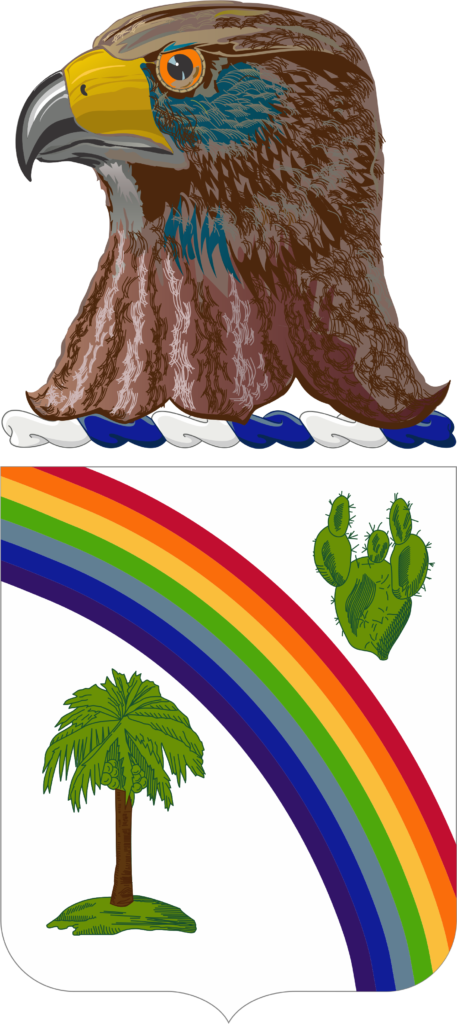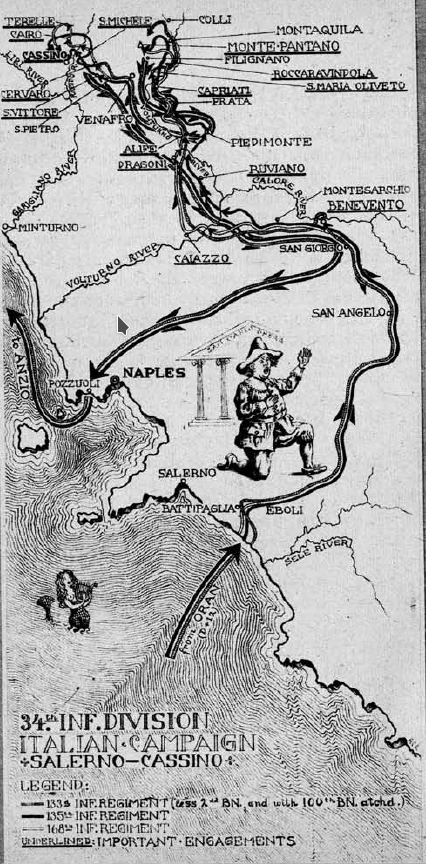

Private Calvin Dale Crandall, the cousin of Wilfred M. Martfeld, from Chambers, Holt County, Nebraska registered for the draft on 30 June 1942 at 18 years of age, married Lela Grimes on 7 November and was enlisted in the US Army by April 1943. Calvin was assigned to Company “E”, 168th Infantry Regiment of the 34th Infantry Division; part of the National Guard of Iowa at the outbreak of World War II[1]. The 34th was the first American division to deploy the European Theater in WW II and by the time Calvin enlisted was already learning the hard lessons of combat in the deserts of north Africa, landing at Oran, Algiers on 8 November 1942. In the first week of February 1943 the 168th was in it’s first important action in North Africa finding themselves up against strong German resistance near Faid Pass, Tunisia where they were “surrounded and cut to pieces”. By 4 April 1943, the 34th Division was engaging Rommel’s army in an operation to seize the Fondouk Gap. By 13 May the fight in Tunisia ended and 34th Division began preparations for the conquest of Sicily.
During this period the 34th was augmented by the 100th Infantry Battalion consisting mainly of Americans of Japanese descent from Hawaii who went on to prove their worth in the Italian campaigns ahead.

Never resting on their laurels, the 34th Division conducted intensive training until it was their turn to participate in the Italian campaign. The 135th and 168th regimental combat teams boarded transports thinking they would disembark at the docks in Naples, but realizing the port would not be taken in time radioed back to the 133th, still in Oran, Algiers to prepare for a beach landing. The 133rd met up with the 135th and 168th off Salerno, Italy where the 133rd had a much easier time going ashore than the other regiments who had prepared for offloading at the docks of Naples. By 29 September 1943, the 34th Division had broken out of their Salerno beachhead and taken Chiusano, beginning their grinding push north up the Italian peninsula.
From 29 November to 4 December 1943, The 168th was engaged in grueling, sometimes hand to hand fighting in an effort to capture Mount Pantano.

Again and again our troops closed with the enemy and the supply of hand grenades frequently gave out. On one occasion, the Germans, having launched a series of counterattacks against the 1st Battalion, 168th Infantry, almost succeeded in overrunning one company. Their grenades exhausted, our soldiers tore down the wall, behind which they were sheltering, rock by rock and threw them at the Germans. The enemy failed to drive us back.[1]
On 4 December all elements of the 168th were relieved on Mount Pantano by the 135th Infantry.
During its six-day test of mental and physical endurance on the mountain the 168th Infantry had lost all it battalion commanders, together with 33 other officers and 386 men killed or wounded. It had expended 6,800 rounds of 81-mm mortar ammunition, 3,000 hand grenades, 7,500 round of 75-mm ammunition, and 400,000 round of rifle and machine gun.[4]
After 76 consecutive days of fighting around Mount Pantano and winning a War Department unit citation for its outstanding performance, The 34th Division was relieved in time to spend Christmas in an area where they could get hot food, baths and clean clothes, but on Christmas Eve the 34th was notified they were to relieve the 36th Infantry Division in the San Pietro sector in a few days. The 168th Infantry became involved in an effort to storm Mount Chiaia. On 7 January 1944, the 168th extended its hold on the ridge above Hill 396.
The 168th had done more than take just another ridge. Its victory at Hill 396 contributed to unhinging the whole enemy defensive system at the junction of his positions in the mountains with those barring the plain.[5]
The 34th division, along with the 168th and other regiments went on fighting in Italy until the end of the war. They conducted another nearly impossible beach landing at Anzio and a continued to push north into the Po Valley area where some 40,000 German troops surrendered to the 34th Division. German troops in Italy officially surrendered on 29 April 1945[6].
PVT Calvin Dale Crandall was killed in action on 7 January 1944, probably while taking the ridge on Mount Chiaia. From his initial landing at Salerno on or about 9 September until his death on 7 January 1944 less than 4 months later, Pvt. Crandall saw nearly constant combat, sometimes hand-to-hand and some in miserable winter mountain conditions, from a determined and relentless enemy. The bravery of Pvt. Crandall, the 168th Infantry Regiment and all the troops involved in the Italian campaigns cannot be overstated. The world owes these soldiers an eternal debt of gratitude.
Calvin was initially buried at a Military cemetery in Maranzelto, Nuavo, Italy, but the the Office of the Quartermasters General conducted a world wide graves registration program and by 1947 were identifying and returning remains from Italy[7]. Calvin’s remains were returned to his father and re-interred at the cemetery in Chambers, Nebraska in August 1948.
Visit Pvt Calvin Dale Crandall’s individual record.
Credits:
- “The 34th Infantry Division, Louisiana to Pisa”, Accessed 26 April 2020. Ike Skelton Combined Arms Research Library Digital Library
- WikipediA, “34th Infantry Division (United States)”, Accessed 26 April 2020.
- WikipediA, “168th Infantry Regiment (United States)”, Accessed 26 April 2020.
- . depothill.net, “34th U.S. INFANTRY DIVISION 168th INFANTRY REGIMENT, November 29th – December 4th 1943”, Accessed 30 April 2020.
- Drive Up to the Gustav Line, “Fifth Army at the Winter Line, 15 November 1943 – 15 January 1944”, Accessed 30 April 2020.
- Service of Choice, “World War II History of The Iowa National Guard”, CW2 David L. Snook, Accessed 30 April 2020.
- Edward Steere and Thayer M. Boardman, “Final Disposition of World War II Dead 1945-51,” Google Books, Accessed 05 May 2020.
Let us never forget.

 PVT Calvin D Crandall, Cassino, Italy 7 January 1944
PVT Calvin D Crandall, Cassino, Italy 7 January 1944